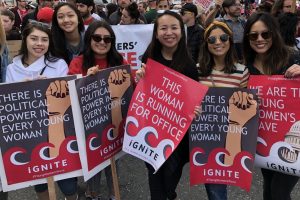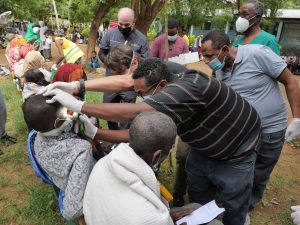MacKenzie Scott has given away over $14 billion to some 1,600 nonprofits since 2019 – a pace of funding unlike any had seen in modern billionaire philanthropy. Up until recently, the process for getting a grant from Scott was opaque. Grant recipients, unaware they were being considered by Scott’s team, would receive a call with the announcement. Some thought they were getting pranked.
The process has been radical in the field of philanthropy, but also critiqued for being too closed.
Until earlier this year, when Scott teamed up with Lever For Change to launch an open call – the first time interested organisations have had a chance to make their own case to Scott. The open call is for 250 $1 million grants open to organisations working with people and places experiencing the greatest need in the United States.
I caught up with Lever for Change CEO Cecilia Conrad to chat about Lever for Change’s experience working with MacKenzie Scott and whether she sees changes in the philanthropy conversation from their work.
Elika Roohi: Tell us how Lever For Change started, and your relationship with the MacArthur Foundation.

A friend shows Elmo how to fly a kite at Azraq Camp, Jordan. Five years ago, Ahlan Simsim, “Welcome Sesame” in Arabic, received $100 million in the John D. and Catherine T. MacArthur Foundation’s first 100&Change competition for a $100 million grant. Credit: Ryan Donnell/Sesame Workshop
Cecilia Conrad: In 2016 or so, the MacArthur Foundation launched an initiative called 100 and Change, where we put out an open call for projects that could use a hundred million dollars to solve a problem – take a big slice of a problem or unlock the resources required to solve the problem. I was the architect of that initiative.
The first recipient of 100 and Change was Sesame Workshop in the International Rescue Committee for early childhood intervention in the Syrian refugee region. We had hundreds of applicants. We had a panel of 400 independent evaluators to read the applications and to make sure that every application got feedback, because one of the things we wanted to do was – with having an open call – to open the doors in ways that philanthropy traditionally is not open, to replace invitation only with an open call. We wanted to do it in a way that I call the humane open call: you want organisations to get to understand what was good about their proposal and what wasn’t good. We thought we were giving some value back by having constructive feedback on every application. So that’s what we did with the first 100 and Change, and it was a big success.
That was the first experience, and we learned from that. We began to think that we could develop this tool we had developed some expertise in and offer it to other funders. We particularly were interested in the funders that say they want to give away a considerable amount of money, but they’re finding it too hard to do, that it’s too hard to source for proposals, that they don’t necessarily want to build big foundations like the MacArthurs or the Carnegies or the Fords of the world. We thought: this is a tool that can help them do that. We can provide the back office and do the management, and we can work with them to design a customised open call. We can put out the word, we can find the judges and do the panelling. We can do this rigorous review process. And then present the donor with a set of highly rated projects from our independent evaluation and let them choose which one they want to fund.
That was the genesis of Lever For Change. We’ve done 11 challenges so far. The 12th, the open call that we’re doing with MacKenzie Scott, is a slightly different model from the earlier ones. But all of those open calls were focused on scaling a solution. So, we set a minimum requirement of at least one grant of $10 million for the organisation, and donors have given grants of $10 million, $20 million – I think there are some that have been $30 million.
The second thing we’re trying to do is create this secondary market. We learned from the first 100 and Change that other donors were interested in what we uncovered through the open call. So, we thought, well this is great because organisations have put in this work, we’ve done all this due diligence, why shouldn’t someone else take these great ideas we’ve found and fund them? With every challenge, there’s a group of finalists and there are other high-scoring projects, and the donor picks which one they’re going to fund. But we take the others, and we get them in front of other donors.
To date the total amount that we have facilitated is now at $1.3 billion – and about half of it is from this work, what I call the secondary market or promoting projects with other funders.
ER: Tell me about working with MacKenzie Scott’s open call.

IGNITE was one of four awardees to receive $10 million from the Lever for Change’s Equality Can’t Wait Challenge. This funding will allow IGNITE to scale its programs and train hundreds of thousands of young women by 2026 to flex their political power as voters, activists, policymakers, commissioners, and candidates. Credit: IGNITE
CC: Our initial set of challenges were very much focused on scaling a single solution. But we have learned that there’s an interest in a different kind of scaling, and that is what I would think of as scaling an ecosystem or scaling a field – that means giving, perhaps supporting multiple organisations in a way that allows them to become stronger and for the field itself to become stronger. That is something new we’ve been offering, and Yield Giving really fits into that because the goal there is to scale the sector. Instead of a single grant for a single project, there will be 250 $1 million grants given to organisations that are smallish by American standards (between $1-5 million in budget).
ER: I want to ask you more about that, because I have seen some criticism of the choice to only open the call to organisations of that size on the basis that it excludes smaller grassroots groups, many of which do valuable work. What would you say in response to that?
CC: Yes, we’ve heard this criticism, and I appreciate the criticism itself. There are a couple of things – one is that there’s the practicality of doing a call of this size and defining what a grant size will be. There’s a real value in trying to set some parameters so that you can have everyone putting forward a proposal for the same size grant. That’s the practical aspect to this.
There is a likelihood, a strong possibility, that if this works, it may happen again with different parameters. There were decisions made about what the first slice of this opportunity would be, and there may be others in the future.
ER: Do you think that other funders are paying attention to what Lever for Change is doing? The open call model is kind of rare among major donors, in the same way the MacKenzie Scott’s style of grantmaking is also rare. Are you seeing conversations shift at all?
CC: I think we are seeing conversations shift, and part of it is Mackenzie Scott. Her grants have attracted a lot of attention. There’s been an active conversation, and philanthropists do listen to what the community is saying. The field itself has spoken loudly about the need for more general operating support, more unrestricted grants. And some of that has certainly influenced what we’ve been doing at Lever For Change. We’ve tried to transfer agency from the donors – who in traditional philanthropy tend to really define exactly what strategy you’re going to use to solve the problem and then find organisations to implement that – to let the organisations tell us how they’re going to solve the problem.
Now, most of our prior grants have been project-based, and that’s one of the other things that’s different about this new model. Because this gives greater agency to the organisations on how they’re going to use the funds. I think it’s important, because, at least in institutional philanthropy, the typical grant size is around $50,000 over 18 months. You can’t do much with that. Right? If we could think big, how could we really make a dent in this? I think that’s a shared goal, and I’m hearing other donors thinking that way. I’m seeing more examples of open calls and challenges that are setting big grant amount. So I’m optimistic.
ER: What does the process look like when Lever For Change is setting up a challenge with a donor?
CC: An open call challenge works best if a donor wants to engage in discovery, wants to find organisations that maybe haven’t been funded in other places or just are not part of the known network. It works best if a donor is willing to cede some control to this process that involves independent evaluation panels who score the projects. It does require that a donor have a particular openness, that’s the best way of describing it. So, we’ll have that conversation.
If the known set of problem solvers is pretty small, then you probably could do a request for proposals, because you have to consider whether it makes sense to have a lot of organisations spend time on an application if you already have restrictive parameters around what you’re going to do. So, that’s the first conversation: does this make sense?
And if it does, then there’s a conversation about defining the topic and the theme – the big issue there is that you want to define something that is broad enough to give the organisations agency. So you can say here’s the problem I’m interested in, for example: gun violence. You don’t then say: I want to find every project that is going to eliminate assault weapons or every project that’s going to put more community centres in neighborhoods – because then you’ve defined the solution. We don’t want to do that. So, you try to get the donor to define the problem at a high level and then to define specific criteria that are going to be important in their decision.
And then we work through the with donor what criteria are most important to them. Some donors want rigorous evidence that something’s been tested; other donors have an appetite for something that’s newer and untested. You see that represented in the scoring rubrics, which we make transparent to everyone who participates.
Then we kind of go off and go to work. And then the engagement with the donor happens once the judges have finished their work scoring the proposals. My team does an analysis, we look at the group of top scoring proposals, map them, do our own due diligence, and then we’ll come back to the donor and help them decide on a group of finalists. The donor picks the finalists, and we then work with those finalists to make their projects even stronger. They usually rewrite their proposals and turn it into a kind of prospectus – they’re a little freer than they are in the original application. They can take all the feedback they’ve gotten through the evaluation process and revise, and they put the best case forward. Then that goes back to the donor, and the donor will sometimes do interviews and will choose their grantee, their awardee.
ER: You said that at the beginning of the process, you have to figure out if the donor is right for the open call. I’m curious whether it’s common that you have a donor come to you with an idea that you then turn down because it turns out it’s not an open call that they want?
CC: I don’t know how we define common, but it certainly happens. I’d say maybe a third of the time. It’s hard to know at this point because people also take a long time to make a decision. But there are donors where I have said I don’t think this is the right fit given what you want. Then there is usually a conversation about how much willing they’re willing to expand their concept so that it’s a bigger question.
This is changing the facts a little bit, but for example, I’ve had donors who will come to us and say: I want to fund a leadership program for girls in college. And I’ll say: why? What’s the goal? If you want to fund leadership programs for girls in college, we could probably put a list together of the leadership programs for girls in college without you having to do this big open call. What did happen in that case – and what happens in lots of cases when we have this conversation – remember, I said the secondary market is trying to get finalists in front of other donors? Well, we have a database of everything that’s been submitted. And so, when a donor comes to me and says: I want to fund leadership programs for girls in college, then I can go through my database and give them a list of projects that already exist. That’s the other way we try to support both the donors and the projects. So sometimes they’re not a good fit for doing one of our open calls, but I’ve got the projects for them, and I can present them to them.
ER: So, with your work, you are both unlocking funding, but also helping all of these funders think about what they actually want to accomplish?
CC: There is a bit of that. And there’s a little bit of proselytising for a more open mindset about what to fund and how to find those projects. There’s a donor we worked with on an open call several years ago, and they’ve since now done it again without us – it was slightly different, more of an open RFP than a big open call, the way we’ve done it – but it was really gratifying. I think the values were replicated.
ER: I want to hear more about this secondary market – the Bold Solutions Network. Was that baked in from the beginning or did you realise, as you did this work, you have this huge database that could be a useful resource?

Himalayan Cataract Project and the Helen Keller Initiative received a 2021 Swift Grant, one of multiple opportunities for Bold Solutions Network members to secure additional funding after participating in one of Lever for Change’s challenges. Credit: Himalayan Cataract Project
CC: Yeah, it was. In the first 100 and Change, we worked with Candid, and they had approached us to ask: what are you going to do with all these projects? And we had other funders who had asked us: what are you gonna do with all these projects. So, we actually had a database then that we created at Candid that had everything – all the submissions to 100 and Change. It was huge. And what we heard was it was kind of overwhelming. But it was still a good resource. So when we started doing Lever For Change, we tried to take that feedback seriously, and we began by focusing in on the finalists and who have gone through and done due diligence and worked on these revised proposals – those are the ones that become members of The Bold Solutions Network.
But as I mentioned, we still have a database of everything, and if a donor is interested, they can approach us, and we can curate for them. They tell us what they’re interested in, and we will go through it and pull out the projects that we have. Or we can even give them access (under an NDA) to the full set, if they are really ambitious. It’s over 6,000 projects in that database.
ER: So, with access to the whole database, that’s when you have funders come to you and say they want to explore something maybe smaller than a full challenge?
CC: Yes, although sometimes they just come to us because, you know, they want to see what we have. I had someone recently who was interested in honeybees, and I was able to find two projects. It can be a really useful resource for someone who just wants to know who’s doing what kind of work. And many of the projects in there, it’s perhaps because they weren’t ready for a $10 million grant. But donors are interested in smaller grants! They might find them really intriguing. It could be that they didn’t line up with the criteria that the original donor defined, but somebody else might find them really exciting. We can make sourcing great opportunities easier for donors. That’s the goal.
ER: Hearing about all of this, it makes me think that there are countless situations where funders or contests end up with an extensive repository of grant applications. Are you thinking about how to systematise something similar to this?
CC: Yes, this is an ongoing conversation. One step in that direction has been work from MacArthur leading the Philanthropy Data Commons project, which an attempt to set up a platform where the most commonly asked questions on grant applications across foundations and institutions are pre-populated, so organisations don’t have to continue to give it again and again and again.
ER: I’ve heard of that. Like the common app for college applications in the U.S.
CC: Yeah, but grants.
And you know, across our challenges, we have created a common template. Most of our challenges have very similar questions. You’ll see organisations, when they fit the parameters, they can easily apply to multiple ones.
ER: Are you looking to start taking on these broader open calls like the one with Yield Giving? What does the future look like for Lever For Change?
CC: Well, we’re certainly adding this new service to our repertoire. In fact, there was a blog post that posted recently in our newsletter that describes the new service. The idea behind it is that we don’t expect a lot of donors are going to give 250 $1 million dollar, but it opens the door to a donor who wants to commit a significant amount of philanthropic capital, like $20 million, to a field and give out a lot of grants under that umbrella.
Elika Roohi is Digital Editor of Alliance magazine




Comments (0)